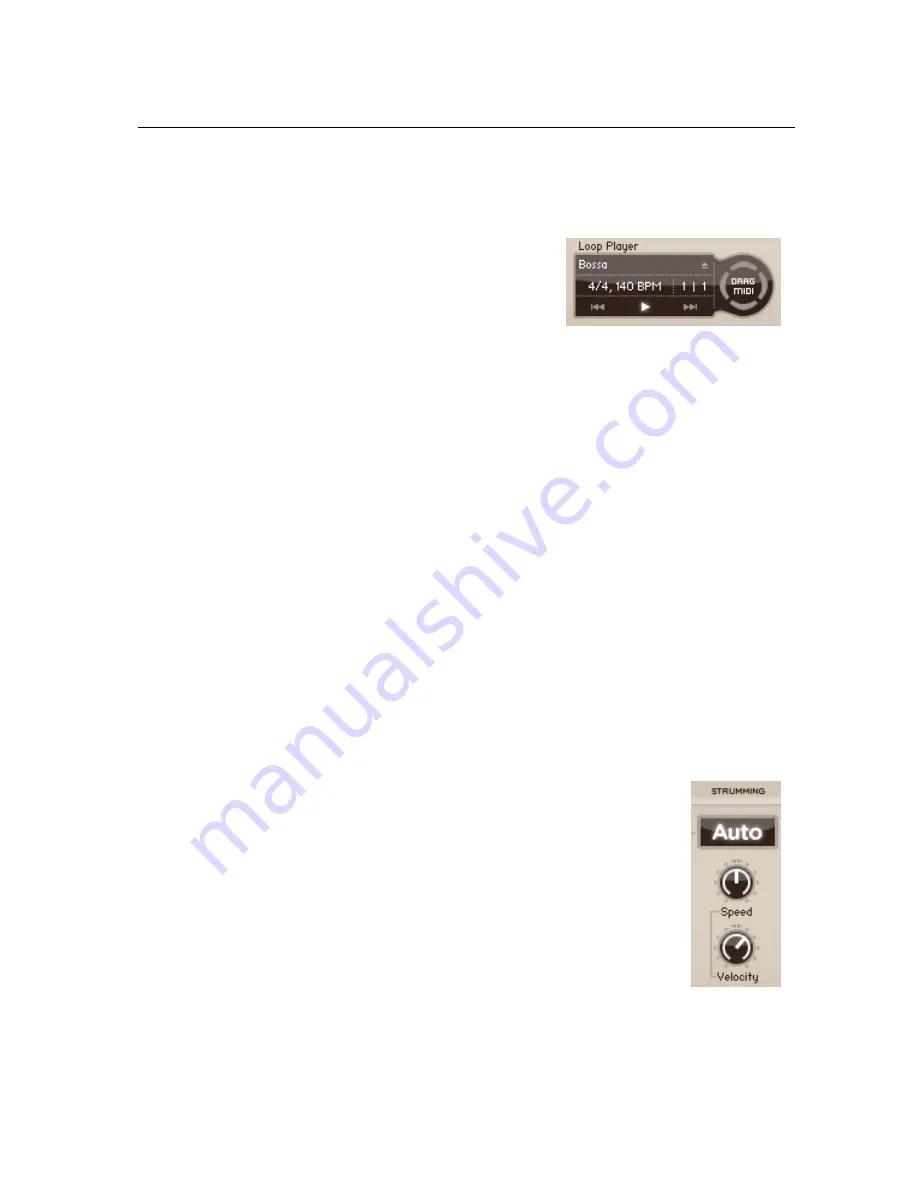
6.7
Performance Parameters
63
only contain strumming sequences and the loop player is then used to play rhythmic or strumming
patterns over chords currently played on the keyboard. Using loops is useful to carefully control or
edit a performance or execute passages that are difficult to play on the keyboard.
Loops are loaded using the
Load
button of the player. This
will open a folder from which loops can be selected. If a loop
was already loaded in the player, the
Load
button will open the
folder where this loop is located. If the player is empty, this
button will open a default loop folder which can be specified
in the
Preferences
dialog from the
Edit
menu of the application. Loops can also be loaded by
clicking on them and drag-and-dropping them onto the MIDI loop player.
Once a loop is loaded, its name is displayed in the top part of the loop player. Information on
the tempo and time signature of the loop is displayed just below its name. The loop is started by
clicking on the
Play
button located in the lower part of the player. Once a loop has been started,
it can be stopped by clicking on the
Pause
button and then restarted again by clicking on the
Play
button. While a loop is being played, indication on the current position within the loop is displayed
on the right of the middle section of the player. The position is indicated, from left to right, as
the current bar number and current beat within this bar. When a loop is loaded in the player, it is
possible to scan the loops in the same folder using the
skip forward
and
skip backward
buttons.
The loops are scanned in alphabetical order starting from the currently loaded loop.
Once a loop has been selected, it might be necessary to modify it. A loop can rapidly be
exported to the MIDI track of a sequencer by using the
Drag MIDI
button. To export the loop,
click on the
Drag MIDI
button, then drag-and-drop the file onto a MIDI track of a sequencer.
Strum
is supplied with a library of MIDI loops which you can use to easily start creating a new
piece. The factory setting for the default MIDI loop folder is the folder where the library was first
copied when
Strum
was installed.
6.7.4
Strumming
The
Strumming
section includes parameters which are used to determine how
the strumming is performed. The
Speed
parameter controls how rapidly the dif-
ferent strings are played when a strum is triggered. The speed of the strum is
increased by turning the knob clockwise. This parameter can be modulated by the
keyboard velocity using the
Velocity
knob. When in its center position, the speed
is always that corresponding to the value of the
Speed
knob. Turning the velocity
knob clockwise increases the strumming speed for high keyboard velocities while
it reduces the speed for low keyboard velocities. Turning this knob below its mid-
dle position has the opposite effect; playing softly on the keyboard will increase
the strumming speed while playing hard will reduce the speed.
The
Auto
button is used to switch
on
or
off
the
Auto-Strum
mode. When this mode is
on
, notes
and chords will played by
Strum
as they are played on the keyboard. When
Auto-Strum
mode is
Содержание Strum Acoustic GS-1
Страница 1: ...USER MANUAL ...
Страница 8: ...8 CONTENTS 12 License Agreement 86 ...
Страница 22: ...22 An Overview of Strum Acoustic Figure 9 General architecture of Strum ...






























